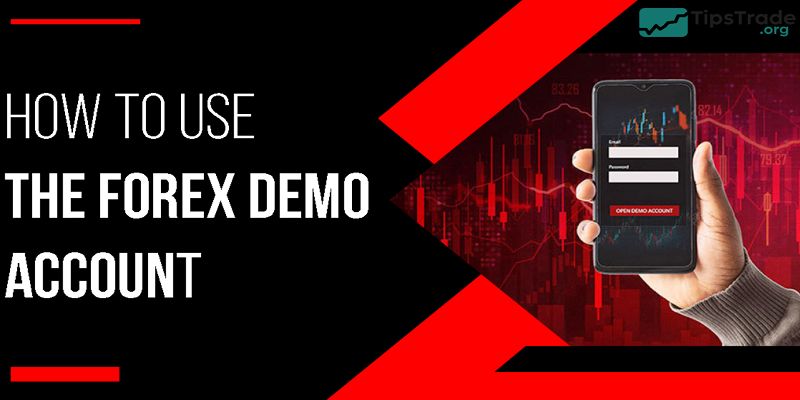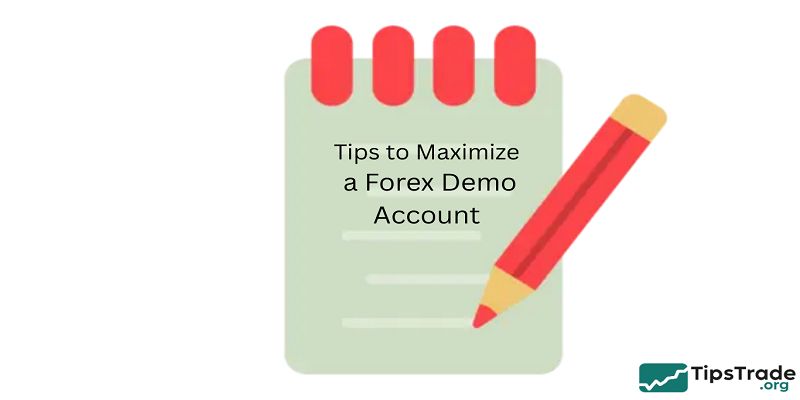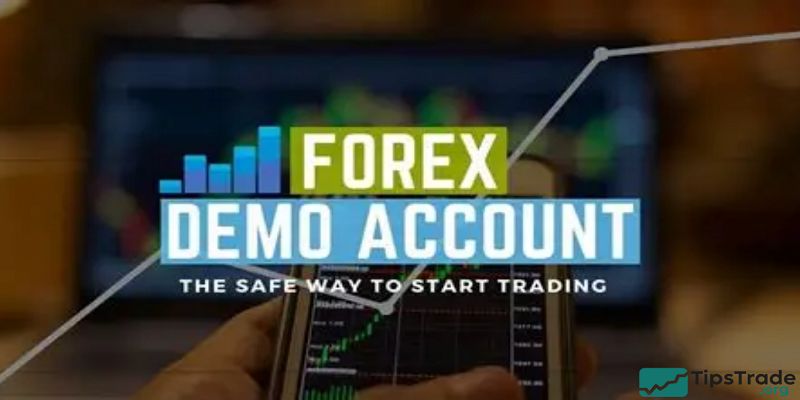Forex demo account is an essential tool for anyone interested in learning how to trade foreign exchange without risking real money. It allows traders, especially beginners, to practice strategies, understand market dynamics, and build confidence in a risk-free environment. Through this article, let’s explore in detail with tipstrade.org how a forex demo account works and why it should be the first step in your trading journey.
What is a Forex Demo Account?

- A forex demo account is a simulated trading account that allows traders to practice forex trading using virtual funds rather than real money.
- The purpose of the demo account is to enable traders, especially beginners, to familiarize themselves with the trading platform, understand market dynamics, and test trading strategies without any financial risk.
Definition and Purpose
- It mirrors live market conditions, providing real-time price data and charts.
- It helps users explore and learn the functionalities of the trading platform.
- It allows for skill development, including technical and fundamental analysis, risk management, and order placement.
- It serves as a risk-free environment to build confidence before moving to live trading.
Key Differences Between Demo and Live Accounts
- Funds: Demo accounts use virtual funds, while live accounts trade with real money.
- Risk: Demo trading carries zero financial risk; live trading involves real financial risks and rewards.
- Emotions: Demo trading lacks the emotional pressure and psychological stress present in live trading.
- Execution: Some differences in liquidity, slippage, and execution speed might exist between demo and live environments.
Main Features
- Virtual Funds: Practice trading with simulated money that can often be replenished or reset.
- Real-Time Data: Prices, charts, and news reflect real market conditions.
- Zero Financial Risk: No real money is at risk, making it an ideal learning environment.
- Full Platform Access: Ability to test various trading tools, indicators, and order types.
- Multiple Instruments: Opportunity to trade various currency pairs, commodities, and more within the account.
Reasons to Use a Forex Demo Account

Risk-Free Practice – Trade Without Losing Real Money
- A forex demo account allows traders to practice trading using virtual funds, eliminating the risk of losing real money while learning how to trade.
- This risk-free environment is crucial for beginners to build confidence and understand trade execution without financial consequences, making mistakes part of the learning process rather than costly errors.
Learn Trading Platforms – MT4, MT5, or Broker Apps
- Demo accounts provide an opportunity to familiarize yourself with popular trading platforms like MetaTrader 4 (MT4), MetaTrader 5 (MT5), or specific broker trading apps.
- Users can explore features, place different types of orders, and navigate menus, helping traders feel comfortable and efficient before moving into live trading.
Strategy Testing – Backtesting vs. Forward Testing
- With a demo account, traders can experiment and validate their trading strategies.
- Backtesting involves testing strategies on historical data, whereas forward testing uses current, live market conditions in the demo environment.
- This dual approach helps traders optimize strategies in simulated real-world conditions without risking capital.
Understanding Market Psychology – Emotions in Demo vs. Live Trading
- Trading on a demo helps traders learn market behavior and decision-making processes but lacks the emotional pressure from real money risk.
- While it helps build discipline and strategy, the psychological aspect of fear and greed in live trading is stronger, so demo trading serves as a preparatory step for managing emotions in actual trading
How to Open a Forex Demo Account (Step-by-Step)

Choose a reliable forex broker
- Research and select a reputable broker offering demo accounts, considering factors like regulation, platform options, fees, and customer support.
Register for a demo account
- Visit the broker’s official website and find the demo account registration section. Fill out the form with your personal details such as name, email, phone number, and country.
Download MT4/MT5 or broker’s platform
- After registration, download the trading platform provided by the broker, usually MetaTrader 4 (MT4), MetaTrader 5 (MT5), or the broker’s proprietary platform. Many brokers also offer web-based platforms requiring no installation.
Log in with demo credentials
- Use the login details sent by the broker via email to access the platform.
Start practicing with virtual capital
- Your demo account will be credited with virtual funds to practice trading.
- Use this risk-free environment to explore the platform’s features, try different trading strategies, and build your skills before trading live
Key Features of Forex Demo Accounts
- Real-time market prices: Demo accounts provide live market data, allowing traders to experience price movements and market conditions exactly as in the real market.
- Virtual capital: Typically, demo accounts come preloaded with virtual funds, often starting at amounts like $10,000 or $50,000, enabling traders to practice with ample capital without risking real money.
- Wide range of instruments: Traders can access various trading instruments such as forex currency pairs, indices, commodities, and sometimes cryptocurrencies, giving broad exposure to different markets.
- Access to charts, indicators, and automated trading tools (EAs): Demo accounts include full access to technical analysis tools, customizable charts, built-in and custom indicators, and the ability to use Expert Advisors (automated trading software).
- Compatibility: Demo trading platforms are generally available across desktop applications, web browsers, and mobile devices, allowing traders to practice anywhere at any time with full platform functionality.
Advantages of Using a Forex Demo Account
- Safe learning environment for beginners: A demo account lets new traders learn and practice forex trading without the fear of losing real money, providing a stress-free environment to build foundational skills.
- Hands-on experience with real market conditions: Demo accounts simulate live market conditions with real-time prices and charts, giving traders realistic practice in understanding market movements and executing trades.
- Builds trading confidence: By practicing trading strategies and platform navigation risk-free, traders gain the confidence needed before committing real funds in a live account.
- Practice risk management techniques: Traders can experiment with different risk management approaches, including position sizing, stop losses, and take profits, without any real financial consequence.
- Free access, no deposit required: Demo accounts are offered free by most brokers and require no initial deposit, making them accessible to anyone interested in learning forex trading.
Limitations of Forex Demo Accounts
- No real financial risk → emotions are different: Since demo accounts use virtual money, traders do not experience the real emotional pressure of risking actual capital. This can lead to unrealistic confidence and less disciplined trading compared to live trading where real money is at stake.
- Unrealistic execution (ideal spreads, no slippage): Demo accounts often simulate ideal trading conditions with tight spreads, instant order execution, and no slippage. In contrast, live trading involves variable spreads, slippage, and sometimes delayed execution especially in volatile markets, which can affect strategy outcomes.
- Limited duration (some expire in 30–90 days): Many brokers limit how long a demo account remains active, usually between one to three months, after which access might be revoked or trading history lost. This limits long-term testing and trading experience.
- Overconfidence when switching to live trading: Success in demo trading can create a false sense of security and lead traders to take bigger risks or trade differently with real money. The emotional and financial pressures of live trading often cause performance to differ significantly from demo results.
Tips to Maximize a Forex Demo Account

- Treat demo trades like real money: Act as if the virtual capital is your real money to cultivate discipline and avoid developing bad trading habits that won’t translate well into live trading.
- Develop and follow a trading plan: Create a detailed trading plan including when to trade, which markets and strategies to focus on, and risk management rules. Trade the demo account following this plan to build consistency.
- Practice risk management: Use stop losses, limit your position sizes, and practice other risk management techniques rigorously. This builds good habits that protect capital when trading live.
- Keep a trading journal and track performance: Document each trade’s reasons, results, and lessons learned. This helps in analyzing what works and what doesn’t, improving your skills over time.
- Transition gradually from demo to live trading: Don’t rush to trade with real money right after demo success. Start with small amounts and gradually increase exposure as confidence and skills solidify.
Best Forex Brokers Offering Demo Accounts
| Broker | Features & Advantages |
| Exness | – Flexible virtual funds and leverage settings
– Supports MT4, MT5, and Exness proprietary platforms – Demo account replicates live trading conditions with realistic spreads – Offers extensive educational resources and TradingView integration – Demo access valid for 21 days with easy account setup |
| Forex.com | – $50,000 virtual capital in demo account
– Real-time market pricing and access to 80+ forex pairs – Supports web and mobile platforms – 90-day demo account validity providing extended practice time – Offers customizable charts, drawing tools, and technical indicators |
| AvaTrade | – Unlimited demo accounts with virtual funds
– Access to MT4, MT5, and AvaTrade WebTrader platform – Mobile app support for iOS and Android – Suitable for both beginners and professional traders – Ideal for testing different account types and trading strategies |
| eToro | – $100,000 virtual funds available
– Proprietary platform with social and copy trading features – Real-time market simulation – Intuitive interface suitable for beginners – Allows seamless transition from demo to live account |
| FP Markets | – $100,000 virtual balance in demo mode
– Real-time prices and charts on MT4, MT5, cTrader, and TradingView – Option to choose Standard or Raw account types – Strong reputation for transparency and low spreads – Suitable for a wide range of trading styles |
Demo Account vs Live Account – Key Differences
| Aspect | Demo Account | Live Account |
| Capital | Virtual money | Real money |
| Risk | No financial risk | Actual financial risk |
| Psychology | No pressure or emotional stress | Experiences stress, fear, and greed |
| Execution | Often ideal with tight spreads and no slippage | Real market conditions with possible slippage, re-quotes, and variable spreads |
Common Mistakes Traders Make with Demo Accounts
- Overtrading because of “free money”: Traders often take too many trades or excessive risks since they are using virtual funds, leading to poor decision-making that won’t translate well to live trading.
- Ignoring proper risk management: Many neglect using stop losses, proper position sizing, and other risk control techniques because there is no real financial loss, forming bad habits for live trading.
- Not recording trades: Failing to keep a trading journal prevents learning from mistakes or successes, limiting growth and improvement as a trader.
- Staying in demo mode too long: Prolonged dependence on demo trading can cause overconfidence and delay transitioning to live trading, missing the experience of real market psychology and pressures
When to Switch from Demo to Live Trading?
- Signs You Are Ready to Go Live:
- Consistent profitability on the demo account over time, showing that your trading strategy is working and not based on luck.
- Emotional preparedness to handle the stress, fear, and greed that come with live trading using real money.
- Confidence in your ability to manage losses and stick to your trading plan during losing trades.
- Understanding of proper risk management and consistent application of it in your trades.
- Recommended Approach: Start Small
- Begin live trading with small position sizes to manage risk effectively while gaining real market experience.
- Gradually increase trade size as confidence and experience grow, rather than jumping in with large amounts immediately.
- Combining Demo + Live for Better Learning
- Continue using a demo account alongside live trading to test new strategies or practice without risking capital.
- This combined approach helps maintain skill development while adjusting to live market conditions incrementally.
Conclude
Forex demo account remains the best starting point for anyone eager to enter the world of forex trading. By providing a risk-free environment to practice and learn, it helps traders build essential skills and confidence before investing real money.

